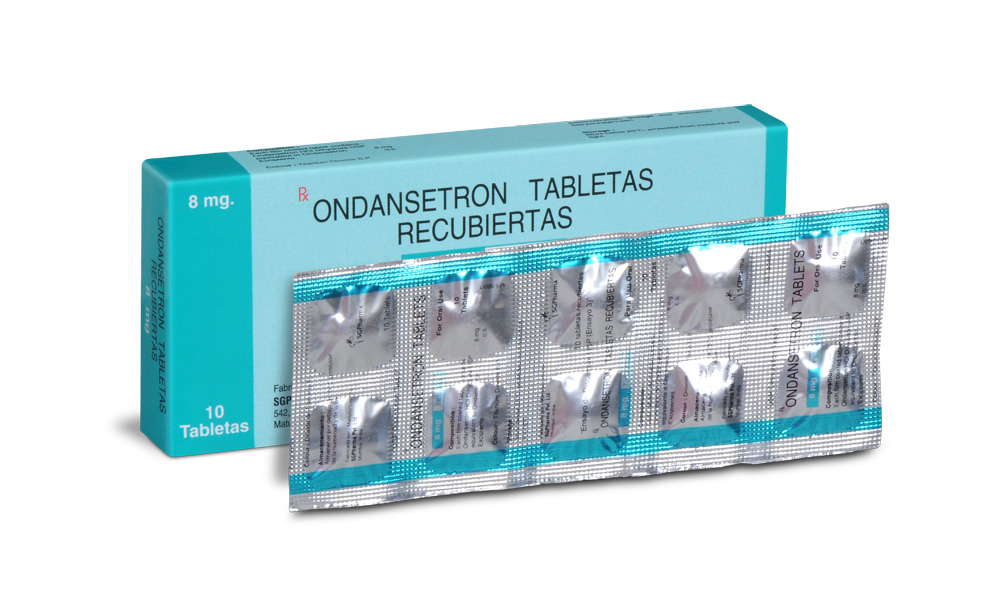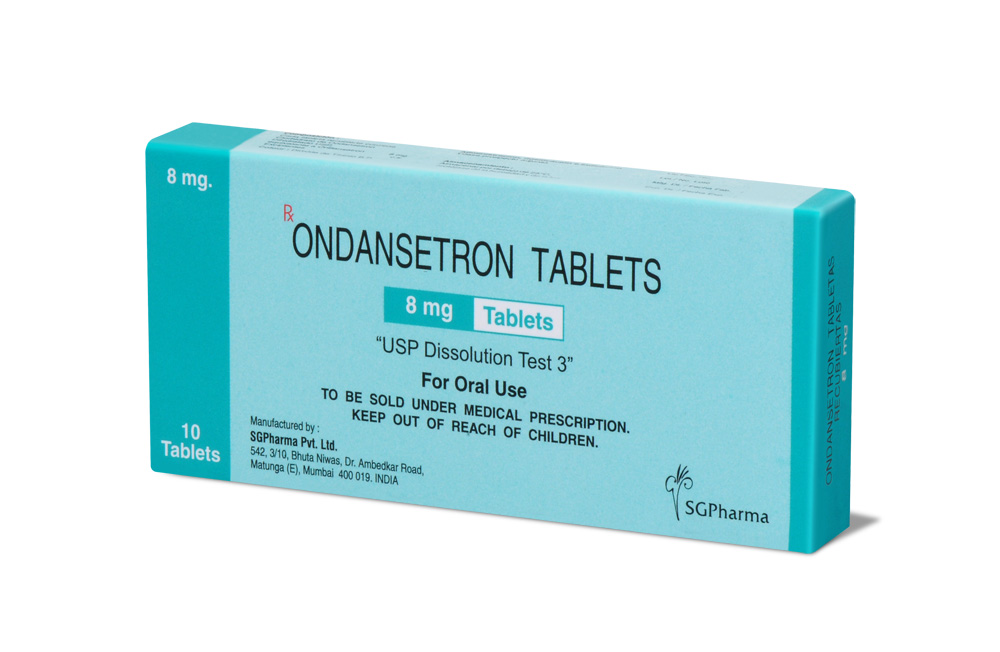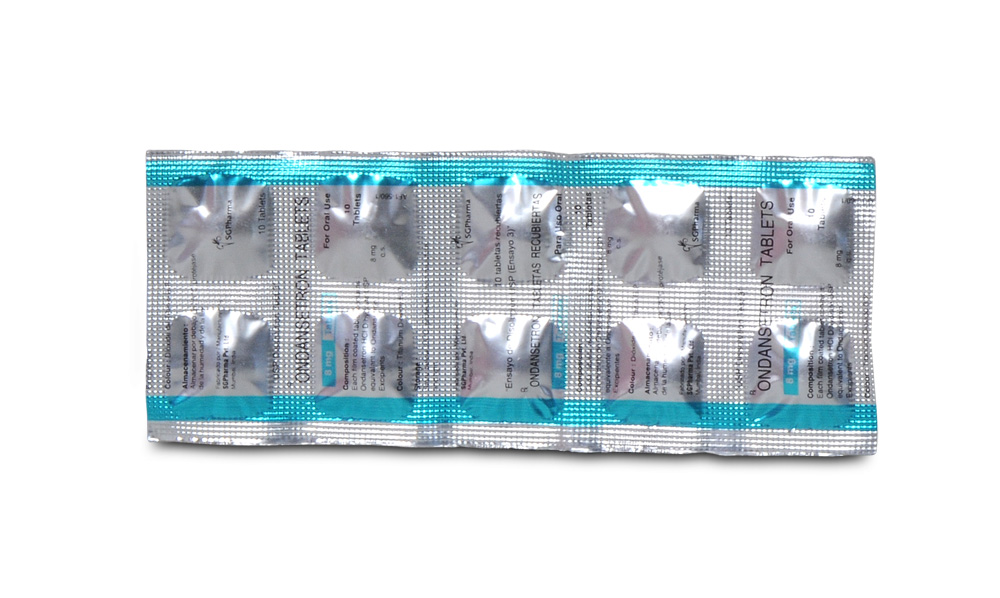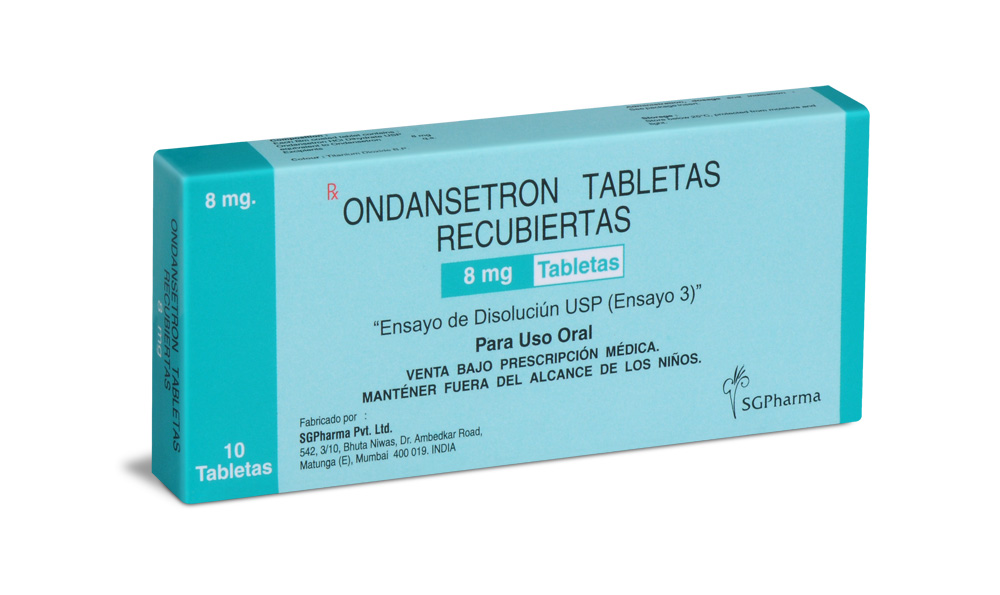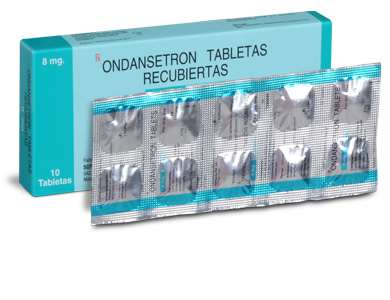
8 mg
For the use of a Registered Medical Practitioner or a Hospital or a Institution only.
Ondansetron Tablets USP (Ondansetron HCl) is a racemic form of ondansetron and a selective blocking agent of the serotonin 5-HT3 receptor type. Chemically, Ondansetron HCl is 4H-Carbazol-4-one,1,2,3,9-tetrahydro-9-methyl-3-(2-methyl-1H-imidazol-1-yl)methyl-, monohydrochloride, (±)-,dihydrate. Its molecular formula is C18H19N3O.HCl.2H2O and its molecular weight is 365.86.
STRUCTURAL FORMULA :
Its structural formula is :
-STRUCUTRE.jpg)
Ondansetron Tablets USP is white circular film coated tablet having plain on one side and embossed “8” on other side of tablet.
COMPOSITION :
Each film coated tablet contains :
Ondansetron HCl Dihydrate USP
equivalent to Ondansetron 8 mg
Excipients q.s.
Colour : Titanium Dioxide B.P.
ACTIONS :
Ondansetron is a potent, highly selective 5HT3 receptor-antagonist. Its precise mode of action in the control of nausea and vomiting is not known. Chemotherapeutic agents and radiotherapy may cause release of 5HT in the small intestine initiating a vomiting reflex by activating vagal afferents via 5HT3 receptors. Ondansetron blocks the initiation of this reflex. Activation of vagal afferents may also cause a release of 5HT in the area postrema, located on the floor of the fourth ventricle and this may also promote emesis through a central mechanism. Thus, the effect of ondansetron in the management of the nausea and vomiting induced by cytotoxic chemotherapy and radiotherapy is probably due to antagonism of 5HT3 receptors on neurons located both in the peripheral and central nervous system. The mechanisms of action in post-operative nausea and vomiting are not known but there may be common pathways with cytotoxic induced nausea and vomiting. Ondansetron does not alter plasma prolactin concentrations. The role of ondansetron in opiate-induced emesis is not yet established.
PHARMACOKINETICS :
Following oral administration, ondansetron is rapidly absorbed with peak plasma concentrations being reported about 1.5 to 2 hours after an oral dose of 8 mg. The absolute bioavailability is about 60 %, due mainly to hepatic first-pass metabolism. It is extensively distributed in the body; results in vitro suggest that about 70 to 75 % of the drug in plasma is protein bound. It is cleared from the systemic circulation predominantly by hepatic metabolism through multiple enzymatic pathways, with less than 5 % of a dose being excreted in urine unchanged: clearances of around 6 ml/minute per kg have been reported in young, healthy subjects. In elderly subjects, bioavailability may be somewhat higher (65 %) and clearance lower (4 to 5 ml/minute per kg), presumably due to reduced hepatic metabolism. The terminal elimination half-life is about 3 hours in younger subjects, prolonged to about 5 hours in the elderly and in those with renal impairment. These differences are not considered sufficient to warrant dosage adjustment; however, in patients with severe hepatic impairment, in whom bioavailability may approach 100 % and clearance is markedly slowed, with elimination half-lives of 15 to 32 hours, dosage restriction is advisable. Children also have reduced clearance, which is age-related; use of weight-based doses compensates for this change. In humans, carmustine, etoposide, and cisplatin do not affect the pharmacokinetics of ondansetron.
INDICATIONS :
1. Prevention of nausea and vomiting associated with highly emetogenic cancer chemotherapy, including cisplatin ≥50 mg/m2.
2. Prevention of nausea and vomiting associated with initial and repeat courses of moderately emetogenic cancer chemotherapy.
3. Prevention of nausea and vomiting associated with radiotherapy in patients receiving total body irradiation, single high-dose fraction to the abdomen, or daily fractions to the abdomen.
4. Prevention of postoperative nausea and/or vomiting. As with other antiemetics, routine prophylaxis is not recommended for patients in whom there is little expectation that nausea and/or vomiting will occur postoperatively. In patients where nausea and/or vomiting must be avoided postoperatively, ondansetron orally disintegrating tablets are recommended even where the incidence of postoperative nausea and/or vomiting is low.
Administration :
For oral use.
Dosage :
Chemotherapy and Radiotherapy
Adults : The emetogenic potential of cancer treatment varies according to the doses and combinations of chemotherapy and radiotherapy regimens used. The route of administration and dose of Ondansetron hydrochloride should be flexible in the range of 8 to 32 mg a day and selected as shown below :
Emetogenic chemotherapy and radiotherapy : Ondansetron hydrochloride can be given either by rectal, oral (tablets or syrup), intravenous or intramuscular administration. For most patients receiving emetogenic chemotherapy or radiotherapy, Ondansetron hydrochloride 8 mg should be administered as a slow intravenous or intramuscular injection immediately before treatment, followed by 8 mg orally twelve hourly. To protect against delayed or prolonged emesis after the first 24 hours, oral or rectal treatment with Ondansetron hydrochloride should be continued for up to five days after a course of treatment.
Highly emetogenic chemotherapy : For patients receiving highly emetogenic chemotherapy, e.g. high-dose cisplatin, Ondansetron hydrochloride can be given either by rectal, intravenous or intramuscular administration. Ondansetron hydrochloride has been shown to be equally effective in the following dose schedules over the first
24 hours of chemotherapy : A single dose of 8 mg by slow intravenous or intramuscular injection immediately before chemotherapy. A dose of 8 mg by slow intravenous or intramuscular injection immediately before chemotherapy, followed by two further intravenous or intramuscular doses of 8 mg two to four hours apart, or by a constant infusion of 1 mg/hour for up to 24 hours. A single dose of 32 mg diluted in 50 to 100 ml of saline or other compatible infusion fluid and infused over not less than 15 minutes immediately before chemotherapy.
The selection of dose regimen should be determined by the severity of the emetogenic challenge. The efficacy of ondansetron hydrochloride in highly emetogenic chemotherapy may be enhanced by the addition of a single intravenous dose of dexamethasone sodium phosphate, 20 mg administered prior to chemotherapy. To protect against delayed or prolonged emesis after the first 24 hours, oral or rectal treatment with ondansetron hydrochloride should be continued for up to five days after a course of treatment.
Children : Ondansetron hydrochloride may be administered as a single intravenous dose of 5 mg/m2 immediately before chemotherapy, followed by 4 mg orally twelve hours later. 4 mg orally twice daily should be continued for up to five days after a course of treatment.
Elderly : Ondansetron hydrochloride is well tolerated by patients over 65 years and no alteration of dosage, dosing frequency or route of administration are required.
Patients with Renal Impairment : No alteration of daily dosage or frequency of dosing, or route of administration are required.
Patients with hepatic Impairment : Clearance of Ondansetron hydrochloride is significantly reduced and serum half-life significantly prolonged in subjects with moderate or severe impairment of hepatic function. In such patients a total daily dose of 8 mg should not be exceeded.
Post-operative nausea and vomiting (PONV) : Adults : For the prevention of PONV ondansetron hydrochloride can be administered orally or by intravenous or intramuscular injection. Ondansetron hydrochloride may be administered as a single dose of 4 mg given by intramuscular or slow intravenous injection at induction of anaesthesia. For treatment of established PONV a single dose of 4 mg given by intramuscular or slow intravenous injection is recommended.
Children (aged 2 years and over) : For prevention of PONV in paediatric patients having surgery performed under general anaesthesia, Ondansetron may be administered by slow intravenous injection at a dose of 0.1 mg/kg up to a maximum of 4 mg either prior to, at or after induction of anaesthesia. For treatment of established PONV in paediatric patients, Ondansetron may be administered by slow intravenous injection at a dose of 0.1 mg/kg up to a maximum of 4 mg. There is limited data on the use of ondansetron hydrochloride in the prevention and treatment of PONV in children under two years of age.
Elderly : There is limited experience in the use of ondansetron hydrochloride in the prevention and treatment of PONV in the elderly, however ondansetron hydrochloride is well tolerated in patients over 65 years receiving chemotherapy.
Patients with renal impairment : No alteration of daily dosage or frequency of dosing, or route of administration are required.
Patients with hepatic impairment : Clearance of ondansetron hydrochloride is significantly reduced and serum half life significantly prolonged in subjects with moderate or severe impairment of hepatic function. In such patients a total daily dose of 8 mg should not be exceeded.
Patients with poor sparteine/debrisoquine metabolism : The elimination half-life of ondansetron hydrochloride is not altered in subjects classified as poor metabolisers of sparteine and debrisoquine. Consequently in such patients repeat dosing will give drug exposure levels no different from those of the general population. No alteration of daily dosage or frequency of dosing are required.
CONTRAINDICATIONS :
Ondansetron tablets are contraindicated for patients known to have hypersensitivity to the drug. Ondansetron tablets contain lactose therefore do not administer in patients with lactose intolerance.
SPECIAL WARNINGS AND PRECAUTIONS :
Hypersensitivity reactions have been reported in patients who have exhibited hypersensitivity to other selective 5HT3 receptor antagonists. As ondansetron is known to increase large bowel transit time, patients with signs of subacute intestinal obstruction should be monitored following administration. Use with precaution in diabetic patients.
Pregnancy :
Teratogenic Effects : Pregnancy Category B.
Reproduction studies have been performed in pregnant rats and rabbits at daily oral doses up to 15 and 30 mg/kg/day, respectively, and have revealed no evidence of impaired fertility or harm to the foetus due to ondansetron. There are, however, no adequate and well-controlled studies in pregnant women. Because animal reproduction studies are not always predictive of human response, this drug should be used during pregnancy only if clearly needed.
Nursing mothers :
Ondansetron is excreted in the breast milk of rats. It is not known whether ondansetron is excreted in human milk. Because many drugs are excreted in human milk, caution should be exercised when ondansetron is administered to a nursing woman.
Paediatric use :
Little information is available about dosage in paediatric patients 4 years of age or younger.
Effects on ability to drive and use machines :
In psychomotor testing ondansetron does not impair performance nor cause sedation.
INTERACTIONS AND INCOMPATIBILITIES :
There is no evidence that ondansetron either induces or inhibits the metabolism of other drugs commonly co-administered with it. Specific studies have shown that there are no pharmacokinetic interactions when ondansetron is administered with alcohol, temazepan, furosemide, tramadol or propofol. Ondansetron is metabolised by multiple hepatic cytochrome P-450 enzymes : CYP3A4, CYP2D6 and CYP1A2. Due to the multiplicity of metabolic enzymes capable of metabolising ondansetron, enzyme inhibition or reduced activity of one enzyme e.g. CYP2D6 genetic deficiency) is normally compensated by other enzymes and should result in little or no significant change in overall ondansetron clearance or dose requirement.
Phenytoin, Carbamazepine and Rifampicin :
In patients treated with potent inducers of CYP3A4 (i.e. phenytoin, carbamazepine, and rifampicin), the oral clearance of ondansetron was increased and ondansetron blood concentrations were decreased.
Tramadol :
Data from small studies indicate that ondansetron may reduce the analgesic effect of tramadol.
SIDE EFFECTS :
Ondansetron is known to increase large bowel transit time and may cause constipation in some patients. The following side effects can occur : headache, a sensation of flushing or warmth, hiccups and occasional asymptomatic increases in liver function tests. There have been rare reports of immediate hypersensitivity reactions sometimes severe including anaphylaxis. Rare cases of transient visual disturbances (e.g. blurred vision) and dizziness have been reported during rapid intravenous administration of ondansetron. There have been rare reports suggestive of involuntary movement disorders such as extrapyramidal reactions e.g. oculogyric crisis/dystonic reactions without definitive evidence of persistent clinical sequelae and seizures have been rarely observed although no known pharmacological mechanism can account for ondansetron causing these effects. Chest pain with or without ST segment depression, cardiac arrhythmias, hypotension and bradycardia have been rarely reported. Occasionally, hypersensitivity reactions around the injection site (e.g. rash, urticaria, itching) may occur, sometimes extending along the drug administration vein.
OVERDOSAGE AND TREATMENT OF OVERDOSAGE :
There is no specific antidote for ondansetron overdose. Patients should be managed with appropriate supportive therapy. Individual intravenous doses as large as 150 mg and total daily intravenous doses as large as 252 mg have been inadvertently administered without significant adverse events. These doses are more than 10 times the recommended daily dose. In addition to the adverse events listed above, the following events have been described in the setting of ondansetron overdose : “Sudden blindness” (amaurosis) of 2 to 3 minutes’ duration plus severe constipation occurred in 1 patient that was administered 72 mg of ondansetron intravenously as a single dose. Hypotension (and faintness) occurred in a patient that took 48 mg of Ondansetron Tablets USP. Following infusion of 32 mg over only a 4 minute period, a vasovagal episode with transient second-degree heart block was observed. In all instances, the events resolved completely.
STORAGE :
Store below 25oC (77oF), protected from moisture and light.
SHELF LIFE :
24 months from the date of manufacture.
PRESENTATION :
Ondansetron Tablets USP contain Ondansetron HCl Dihydrate USP equivalent to Ondansetron 8 mg.
1 strip of 10 tablets per Box.
Disclaimer : For the use of a Registered Medical Practitioner or a Hospital or a Institution only. Also it is not intended to be used by healthcare professionals or patients for the purpose of prescribing or administering these products. Questions regarding the complete and current content of product labeling / specification / presentation should be directed to SGPharma.

 Cardiovascular
Cardiovascular



